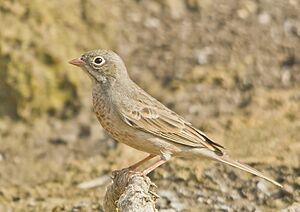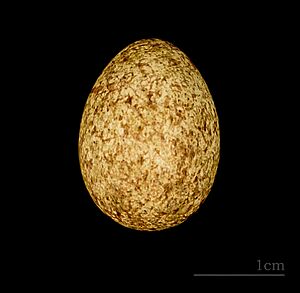Grey-necked bunting facts for kids
Quick facts for kids Grey-necked bunting |
|
|---|---|
 |
|
| Conservation status | |
| Scientific classification | |
| Synonyms | |
|
The grey-necked bunting (Emberiza buchanani) is a small bird in the bunting family. It is sometimes also called the grey-hooded bunting. This bird lives across a large area from the Caspian Sea to the Altai Mountains in Central Asia. When winter comes, it flies south to parts of Southern Asia. Like other buntings, you can often find them in small groups.
What Does the Grey-necked Bunting Look Like?
This bunting has a long, pink beak. Its upper body is mostly grey. Male birds have a clear white ring around their eyes. This white ring stands out against their grey head, which looks like a hood. Their chin and throat are a whitish-pink color. Grey stripes run down the sides of their face, near their mouth. The lower part of their body is a pinkish-brown.
Female buntings look a bit duller than males. However, the stripe near their beak might be easier to see. The feathers on the outer part of their tail are whitish.
A scientist named Edward Blyth first described this bird. He used a drawing by Francis Buchanan-Hamilton, and the bird was named after him. The description was likely published in 1845.
In winter, these birds make a soft click sound. Their song is a metallic jingle. It sounds like swee-swee notes that end with a dzwe-ee-dul.
There are three main types, or subspecies, of the grey-necked bunting. They are called buchanani, neobscura, and ceruttii.
Where Do Grey-necked Buntings Live?
You can usually find these buntings in dry, open places. They like stony, hilly areas with low, thorny bushes. Birds that breed in the Baluchistan region fly to India for the winter. They travel through Gujarat in September and return to their breeding areas in March.
These birds live in many countries. This includes Afghanistan, Armenia, Azerbaijan, Bhutan, Nepal, China, and India. They are also found in Iran, Israel, Kazakhstan, Mongolia, Oman, Pakistan, Russia, Syria, Tajikistan, Turkey, Turkmenistan, and Uzbekistan.
Sometimes, a grey-necked bunting might fly far away from its usual home. This is called being a "vagrant." They have been seen in places like Finland and the Netherlands. It can be hard to spot these wanderers. This is because they look very similar to the ortolan bunting when they are not in their breeding feathers. The ortolan bunting is much more common.
During winter, they also travel to parts of Africa, West Asia, and South Asia. Some even fly as far south as Sri Lanka.
Their natural habitat is temperate grassland. They usually live below 7,000 feet (about 2,100 meters). In winter, they can be found in fields with weeds or leftover crop stubble.
They build their nests on the ground. The nest is usually hidden under some plants that hang over it. They line their nests with grass and hair. The male bird sings from a high spot. His song is a series of short, sharp notes that get louder.
A scientist named Claud Ticehurst noticed something interesting. He saw that male and female grey-necked buntings migrate separately.




